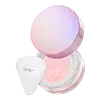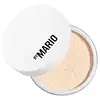Tarte Creaseless Setting & Brightening Powder Versus Makeup by Mario Surrealskin Soft Blur Setting Powder
What's inside
What's inside
 Key Ingredients
Key Ingredients

 Benefits
Benefits

 Concerns
Concerns

 Ingredients Side-by-side
Ingredients Side-by-side

Mica
Cosmetic ColorantSilica
AbrasiveTapioca Starch
Zea Mays Starch
AbsorbentAluminum Starch Octenylsuccinate
AbsorbentLauroyl Lysine
Skin ConditioningAlumina
AbrasiveBoron Nitride
AbsorbentKaolin
AbrasiveWater
Skin ConditioningBenzyl Alcohol
PerfumingCetyl Alcohol
EmollientPhenoxyethanol
PreservativePropanediol
SolventDecylene Glycol
Skin Conditioning1,2-Hexanediol
Skin ConditioningGlycerin
HumectantLonicera Japonica Flower Extract
Skin ConditioningOcimum Basilicum Extract
AntioxidantTrisodium Ethylenediamine Disuccinate
Linalool
PerfumingCitrus Paradisi Fruit Extract
Skin ConditioningVegetable Oil
Skin ConditioningUsnea Barbata Extract
Caprylhydroxamic Acid
Tocopherol
AntioxidantCI 77163
Cosmetic ColorantCI 77742
Cosmetic ColorantCI 77007
Cosmetic ColorantIron Oxides
CI 19140
Cosmetic ColorantMica, Silica, Tapioca Starch, Zea Mays Starch, Aluminum Starch Octenylsuccinate, Lauroyl Lysine, Alumina, Boron Nitride, Kaolin, Water, Benzyl Alcohol, Cetyl Alcohol, Phenoxyethanol, Propanediol, Decylene Glycol, 1,2-Hexanediol, Glycerin, Lonicera Japonica Flower Extract, Ocimum Basilicum Extract, Trisodium Ethylenediamine Disuccinate, Linalool, Citrus Paradisi Fruit Extract, Vegetable Oil, Usnea Barbata Extract, Caprylhydroxamic Acid, Tocopherol, CI 77163, CI 77742, CI 77007, Iron Oxides, CI 19140
Synthetic Fluorphlogopite
Mica
Cosmetic ColorantSilica
AbrasiveLauroyl Lysine
Skin ConditioningKaolin
AbrasiveMagnesium Myristate
Zinc Stearate
Cosmetic ColorantDimethicone
EmollientSqualane
EmollientTetrahexyldecyl Ascorbate
AntioxidantPotassium Sorbate
PreservativeCaprylyl Glycol
Emollient1,2-Hexanediol
Skin ConditioningCI 77491
Cosmetic ColorantCI 77492
Cosmetic ColorantCI 77499
Cosmetic ColorantCI 77742
Cosmetic Colorant
 Reviews
Reviews

Ingredients Explained
These ingredients are found in both products.
Ingredients higher up in an ingredient list are typically present in a larger amount.
1,2-Hexanediol is a synthetic liquid and another multi-functional powerhouse.
It is a:
- Humectant, drawing moisture into the skin
- Emollient, helping to soften skin
- Solvent, dispersing and stabilizing formulas
- Preservative booster, enhancing the antimicrobial activity of other preservatives
This ingredient is used to add a violet color to cosmetics.
It is created by reacting phosphoric acid, ammonium dihydrogen orthophosphate, and manganese dioxide.
Kaolin is a clay. It is used for oil control and to help minimize pores. Like other clays, kaolin has the ability to absorb excess sebum or oil. This can help clean out pores and mattify the skin.
Some types of kaolin may have exfoliating properties. When water is added to kaolin, it becomes a paste with small abrasive particles.
Most kaolin is a white color, but may be pink/orange/red depending on where it comes from.
The name 'kaolin' comes from a Chinese village named 'Gaoling'. Kaolin clay comes from rocks rich in kaolinite. Kaolinite, the mineral, has a silicate layered structure. Kaolinite is formed from chemical weathering of aluminum siilicate minerals.
Besides skincare, kaolin is commonly used to make glossy paper, in ceramics, toothpaste, and as medicine to soothe stomach issues.
Learn more about KaolinThis ingredient comes from a fatty acid (lauric acid) and amino acid (lysine). It is used to add a silky feel to cosmetics.
According to a manufacturer, its fatty acid base leaves a silky feeling on the skin. It also has emollient properties because of this. Emollients help soften skin by preventing water from evaporating.
Lauroyl lysine is barely soluble in water.
Learn more about Lauroyl LysineMica is a naturally occurring mineral used to add shimmer and color in cosmetics. It can also help improve the texture of a product or give it an opaque, white/silver color.
Serecite is the name for very fine but ragged grains of mica.
This ingredient is often coated with metal oxides like titanium dioxide. Trace amounts of heavy metals may be found in mica, but these metals are not harmful in our personal products.
Mica has been used since prehistoric times throughout the world. Ancient Egyptian, Indian, Greek, Roman, Aztec, and Chinese civilizations have used mica.
Learn more about MicaSilica, also known as silicon dioxide, is a naturally occurring mineral. It is used as a fine, spherical, and porous powder in cosmetics.
Though it has exfoliant properties, the function of silica varies depending on the product.
The unique structure of silica enhances the spreadability and adds smoothness, making it a great texture enhancer.
It is also used as an active carrier, emulsifier, and mattifier due to its ability to absorb excess oil.
In some products, tiny microneedles called spicules are made from silica or hydrolyzed sponge. When you rub them in, they lightly polish away dead skin layers and enhance the penetration of active ingredients.
Learn more about Silica